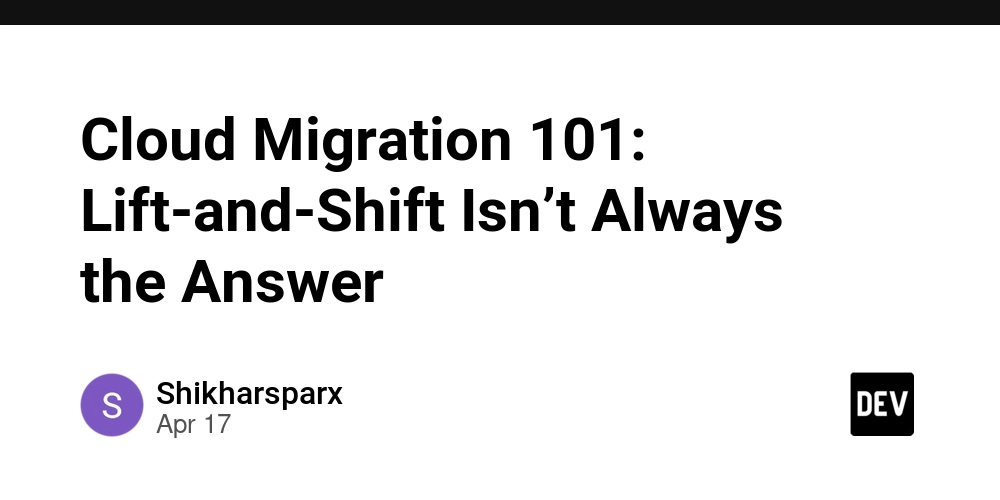Cloud Migration 101: Lift-and-Shift Isn’t Always the Answer
As businesses increasingly turn to cloud computing to enhance flexibility, scalability, and cost-effectiveness, cloud migration has become a critical focus. One common approach to cloud migration is the "lift-and-shift" strategy, which involves moving applications and data from on-premises infrastructure to the cloud with minimal changes. While this method can be appealing for its simplicity and speed, it is not always the best solution for every organization. In this article, we will explore the lift-and-shift approach, its advantages and disadvantages, and alternative strategies for successful cloud migration. Understanding Lift-and-Shift Migration Lift-and-shift migration, also known as rehosting, involves transferring applications and workloads to the cloud without making significant modifications. This approach allows organizations to quickly move to the cloud and start benefiting from its features. Advantages of Lift-and-Shift 1. Speed of Migration: Lift-and-shift is often the fastest way to migrate to the cloud, allowing organizations to quickly transition their workloads and start leveraging cloud resources. 2. Lower Initial Costs: Since this approach requires minimal changes to applications, it can be more cost-effective in the short term compared to other migration strategies. 3. Reduced Complexity: By avoiding extensive modifications, organizations can simplify the migration process and reduce the risk of disruptions during the transition. Disadvantages of Lift-and-Shift 1. Limited Optimization: Applications that are simply lifted and shifted may not take full advantage of cloud-native features, such as auto-scaling, serverless computing, or managed services. 2. Performance Issues: Legacy applications may not perform optimally in the cloud environment, leading to potential slowdowns and inefficiencies. 3. Technical Debt: Continuing to use outdated applications without addressing underlying issues can lead to increased technical debt, making future migrations or upgrades more challenging. When Lift-and-Shift May Not Be the Best Option While lift-and-shift can be a suitable approach for some organizations, it is not always the best choice. Here are scenarios where this strategy may fall short: 1. Complex Applications For applications with complex architectures or dependencies, a lift-and-shift approach may not adequately address performance and integration challenges. In such cases, a more tailored migration strategy may be necessary. 2. Need for Modernization If an organization aims to modernize its applications to improve functionality, user experience, or security, lift-and-shift may not be sufficient. Instead, a more comprehensive approach, such as refactoring or replatforming, may be required. 3. Long-Term Cost Considerations While lift-and-shift may offer short-term cost savings, it can lead to higher long-term costs if applications are not optimized for the cloud. Organizations should consider the total cost of ownership (TCO) when evaluating migration strategies. Alternative Cloud Migration Strategies If lift-and-shift isn’t the right fit for your organization, consider these alternative strategies: 1. Replatforming Replatforming involves making some modifications to applications while migrating them to the cloud. This approach allows organizations to take advantage of cloud-native features without a complete overhaul. - Benefits: Improved performance, cost savings through cloud-native services, and a more gradual modernization process. 2. Refactoring Refactoring entails re-architecting and rewriting applications to fully leverage cloud capabilities. This strategy is the most comprehensive and resource-intensive but can yield significant long-term benefits. - Benefits: Optimal performance, future-proofing applications, and enhanced user experiences. 3. Replacing In some cases, it may be more effective to replace legacy applications with modern, cloud-native solutions. This approach allows organizations to start fresh with applications designed for the cloud. - Benefits: Access to the latest features, improved scalability, and reduced technical debt. Conclusion While lift-and-shift migration can be an appealing option for quickly moving to the cloud, it is not always the best solution for every organization. By understanding the advantages and disadvantages of this approach, as well as considering alternative strategies like replatforming, refactoring, or replacing applications, businesses can make informed decisions that align with their long-term goals.

As businesses increasingly turn to cloud computing to enhance flexibility, scalability, and cost-effectiveness, cloud migration has become a critical focus.
One common approach to cloud migration is the "lift-and-shift" strategy, which involves moving applications and data from on-premises infrastructure to the cloud with minimal changes. While this method can be appealing for its simplicity and speed, it is not always the best solution for every organization.
In this article, we will explore the lift-and-shift approach, its advantages and disadvantages, and alternative strategies for successful cloud migration.
Understanding Lift-and-Shift Migration
Lift-and-shift migration, also known as rehosting, involves transferring applications and workloads to the cloud without making significant modifications. This approach allows organizations to quickly move to the cloud and start benefiting from its features.
Advantages of Lift-and-Shift
1. Speed of Migration: Lift-and-shift is often the fastest way to migrate to the cloud, allowing organizations to quickly transition their workloads and start leveraging cloud resources.
2. Lower Initial Costs: Since this approach requires minimal changes to applications, it can be more cost-effective in the short term compared to other migration strategies.
3. Reduced Complexity: By avoiding extensive modifications, organizations can simplify the migration process and reduce the risk of disruptions during the transition.
Disadvantages of Lift-and-Shift
1. Limited Optimization: Applications that are simply lifted and shifted may not take full advantage of cloud-native features, such as auto-scaling, serverless computing, or managed services.
2. Performance Issues: Legacy applications may not perform optimally in the cloud environment, leading to potential slowdowns and inefficiencies.
3. Technical Debt: Continuing to use outdated applications without addressing underlying issues can lead to increased technical debt, making future migrations or upgrades more challenging.
When Lift-and-Shift May Not Be the Best Option
While lift-and-shift can be a suitable approach for some organizations, it is not always the best choice. Here are scenarios where this strategy may fall short:
1. Complex Applications
For applications with complex architectures or dependencies, a lift-and-shift approach may not adequately address performance and integration challenges. In such cases, a more tailored migration strategy may be necessary.
2. Need for Modernization
If an organization aims to modernize its applications to improve functionality, user experience, or security, lift-and-shift may not be sufficient. Instead, a more comprehensive approach, such as refactoring or replatforming, may be required.
3. Long-Term Cost Considerations
While lift-and-shift may offer short-term cost savings, it can lead to higher long-term costs if applications are not optimized for the cloud. Organizations should consider the total cost of ownership (TCO) when evaluating migration strategies.
Alternative Cloud Migration Strategies
If lift-and-shift isn’t the right fit for your organization, consider these alternative strategies:
1. Replatforming
Replatforming involves making some modifications to applications while migrating them to the cloud. This approach allows organizations to take advantage of cloud-native features without a complete overhaul.
- Benefits: Improved performance, cost savings through cloud-native services, and a more gradual modernization process.
2. Refactoring
Refactoring entails re-architecting and rewriting applications to fully leverage cloud capabilities. This strategy is the most comprehensive and resource-intensive but can yield significant long-term benefits.
- Benefits: Optimal performance, future-proofing applications, and enhanced user experiences.
3. Replacing
In some cases, it may be more effective to replace legacy applications with modern, cloud-native solutions. This approach allows organizations to start fresh with applications designed for the cloud.
- Benefits: Access to the latest features, improved scalability, and reduced technical debt.
Conclusion
While lift-and-shift migration can be an appealing option for quickly moving to the cloud, it is not always the best solution for every organization. By understanding the advantages and disadvantages of this approach, as well as considering alternative strategies like replatforming, refactoring, or replacing applications, businesses can make informed decisions that align with their long-term goals.




























![[Webinar] AI Is Already Inside Your SaaS Stack — Learn How to Prevent the Next Silent Breach](https://blogger.googleusercontent.com/img/b/R29vZ2xl/AVvXsEiOWn65wd33dg2uO99NrtKbpYLfcepwOLidQDMls0HXKlA91k6HURluRA4WXgJRAZldEe1VReMQZyyYt1PgnoAn5JPpILsWlXIzmrBSs_TBoyPwO7hZrWouBg2-O3mdeoeSGY-l9_bsZB7vbpKjTSvG93zNytjxgTaMPqo9iq9Z5pGa05CJOs9uXpwHFT4/s1600/ai-cyber.jpg?#)













































































































































![[The AI Show Episode 144]: ChatGPT’s New Memory, Shopify CEO’s Leaked “AI First” Memo, Google Cloud Next Releases, o3 and o4-mini Coming Soon & Llama 4’s Rocky Launch](https://www.marketingaiinstitute.com/hubfs/ep%20144%20cover.png)





































































































































































































![Rogue Company Elite tier list of best characters [April 2025]](https://media.pocketgamer.com/artwork/na-33136-1657102075/rogue-company-ios-android-tier-cover.jpg?#)







































































_Andreas_Prott_Alamy.jpg?width=1280&auto=webp&quality=80&disable=upscale#)































































































![What’s new in Android’s April 2025 Google System Updates [U: 4/18]](https://i0.wp.com/9to5google.com/wp-content/uploads/sites/4/2025/01/google-play-services-3.jpg?resize=1200%2C628&quality=82&strip=all&ssl=1)








![Apple Watch Series 10 Back On Sale for $299! [Lowest Price Ever]](https://www.iclarified.com/images/news/96657/96657/96657-640.jpg)
![EU Postpones Apple App Store Fines Amid Tariff Negotiations [Report]](https://www.iclarified.com/images/news/97068/97068/97068-640.jpg)
![Apple Slips to Fifth in China's Smartphone Market with 9% Decline [Report]](https://www.iclarified.com/images/news/97065/97065/97065-640.jpg)
































































































































